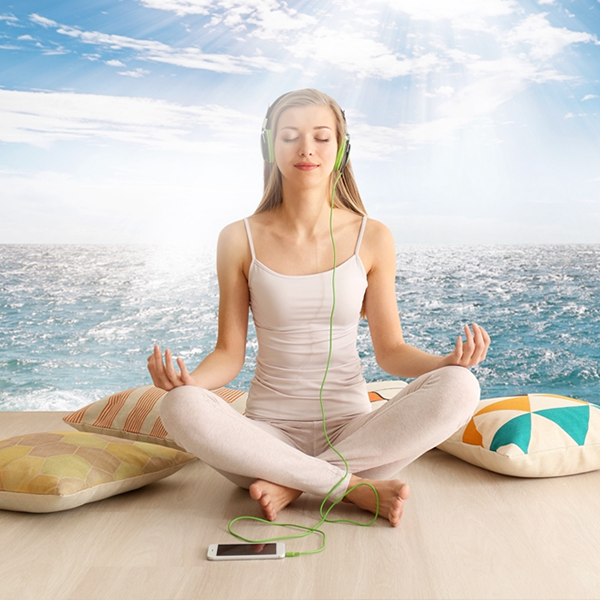
Benefits of a Regular Meditation Practice
- Stress reduction
- Improved focus and attention
- Emotional well-being
- Enhanced self-awareness
- Improved cognitive abilities
- Physical health benefits
Guided meditations and regular meditation practice have been studied extensively, and numerous scientific and behavioral benefits have been associated.
Here are some of the key benefits:
- Stress reduction: Meditation has been shown to reduce stress levels by activating the body’s relaxation response. It can lower the production of stress hormones like cortisol and decrease symptoms of anxiety and depression.
- Improved focus and attention: Regular meditation can enhance focus, attention, and concentration. It strengthens the brain’s ability to sustain attention and resist distractions, improving cognitive performance.
- Emotional well-being: Meditation can promote well-being by increasing positive emotions and reducing negative ones. It has been linked to decreased symptoms of depression and anxiety, improved emotional regulation, and increased feelings of happiness and contentment.
- Enhanced self-awareness: Meditation cultivates self-awareness, allowing individuals to observe their thoughts, emotions, and sensations without judgment. This increased self-awareness can lead to a better understanding of oneself, improved self-acceptance, and the ability to respond to situations more skillfully.
- Improved cognitive abilities: Regular meditation practice has been associated with improved memory, creativity, and problem-solving skills. It can also enhance cognitive flexibility, which is adapting and switching between different tasks or perspectives.
- Better overall well-being: Meditation has improved overall well-being and quality of life. It can increase feelings of calmness, inner peace, and overall life satisfaction.
- Physical health benefits: Meditation has been found to positively affect physical health as well. It can lower blood pressure, improve sleep quality, boost the immune system, and reduce the risk of chronic conditions like heart disease and inflammation.
It’s important to note that the benefits of meditation can vary from person to person, and the scientific evidence supporting these benefits is still growing. However, numerous studies have consistently shown positive effects on mental, emotional, and physical well-being associated with regular meditation practice.
“Be Happy for This Moment.
This Moment is Your Life”
- Omar Khayyam

Meditation is often Practiced for Spiritual Development and Can Offer Various Spiritual Benefits.
- Increased self-awareness
- Connection to the present moment
- Expanded consciousness
- Deepened sense of purpose and meaning
- Cultivation of compassion and loving-kindness
- Transcendence of ego
Here are some of the spiritual benefits commonly associated with meditation:
1. Increased self-awareness: Meditation cultivates a deep self-awareness, allowing individuals to observe their thoughts, emotions, and sensations without judgment. This heightened self-awareness can lead to a greater understanding of one’s true nature and inner self.
2. Connection to the present moment: Meditation encourages individuals to focus on the present moment and let go of worries about the past or future. This presence and mindfulness can foster a deeper connection to the present moment, enhancing one’s spirituality and appreciation for the here and now.
3. Expanded consciousness: Some individuals report experiencing expanded or altered states of consciousness through regular meditation practice. These experiences can provide a sense of connection to something greater than oneself and a deeper understanding of the interconnectedness of all things.
4. Deepened sense of purpose and meaning: Meditation can help individuals explore their values, beliefs, and life purpose. By quieting the mind and connecting with one’s inner self, meditation can provide clarity and insight into one’s life path, leading to a deepened sense of purpose and meaning.
5. Cultivation of compassion and loving-kindness: Many meditation practices involve cultivating qualities such as compassion, loving-kindness, and forgiveness. By directing positive intentions and goodwill towards oneself and others, individuals can develop a greater sense of empathy, compassion, and interconnectedness with all beings.
6. Transcendence of ego: Meditation can facilitate a transcendence of the ego, the sense of a separate and individual self. Through practices like mindfulness or self-inquiry, individuals may experience a dissolution of boundaries and a sense of unity with the universe or a higher power.
It’s important to note that the spiritual benefits of meditation are subjective and can vary from person to person. Different meditation techniques and traditions may emphasize different aspects of spirituality. Ultimately, the spiritual benefits of meditation are deeply personal and can be influenced by one’s beliefs, experiences, and intentions.
“The Purpose of Our Lives is to Be Happy”
- Dalai Lama
Best practices for your meditation journey:
Setting up for a meditation practice involves creating a conducive environment that supports focus, relaxation, and mindfulness.
1. Find a quiet and comfortable space: Choose a quiet area to minimize distractions and interruptions. It could be a dedicated meditation room, a corner of a room, or any space where you feel calm and at ease. Ensure the space is clean and clutter-free.
2. Settle into a comfortable posture: Find a posture that allows you to be both relaxed and alert. This could be sitting on a cushion or chair with a straight back or even lying down if you tend to fall asleep. Experiment with different postures to find what works best for you.
3. Create a calming atmosphere: Use soft or natural light if possible. Consider using candles, incense, or essential oils with calming scents like lavender or sandalwood to create a soothing ambiance. Play gentle instrumental music or nature sounds if it helps you relax.
4. Use props if needed: If you find it challenging to maintain a comfortable posture, you can use props like meditation cushions, blankets, or a meditation bench to support your body. These props can help you maintain proper alignment and reduce physical discomfort.
5. Minimize distractions: Turn off or silence your phone and other electronic devices to minimize distractions. If you live with others, let them know that you’ll be meditating and request some uninterrupted time. Consider using a “Do Not Disturb” sign or setting boundaries to ensure a peaceful environment.
6. Use the In2Bliss meditation tracker: If you are not using a guided meditation, use a timer to set a specific duration for your meditation session. This helps you stay focused and ensures you don’t have to worry about checking the time. Start with shorter durations and gradually increase as you build your practice.
7. Establish a ritual: Create a simple ritual to signal the beginning and end of your meditation practice. It could be lighting a candle, taking a few deep breaths, or reciting a short mantra. This ritual helps transition your mind and body into a meditative state.
8. Practice consistency: Establish a regular meditation routine by setting aside dedicated daily time for your practice. Consistency is critical to reaping the benefits of meditation. Start with shorter sessions and gradually increase the duration as you become more comfortable.
Remember, the most essential aspect of setting up for a meditation practice is creating an environment that supports your focus, relaxation, and mindfulness. Experiment with different elements and adjust them based on your preferences and needs. Over time, you’ll develop a setup that enhances your meditation experience.
“Stand Fully in the Now Moment With Gratitude, Enthusiasm, Openness, and Readiness to Respond to Life as It Greets You””
- Michael Beckwith
***This work is not intended to substitute for professional medical or counseling advice. If you suffer from a physical or mental illness, please always seek professional help***
***PLEASE do not listen to guided meditations while operating machinery or driving. They are best used with headphones and sitting or lying in a comfortable, quiet place where you will not be disturbed***
Regular new content updated weekly